 |
Picks is a monthly sampling of Japan's art scene, offering short reviews of 20 exhibitions at museums and galleries throughout Japan over the past two or three months, with an emphasis on contemporary art by young artists. |
 |
 |
 |
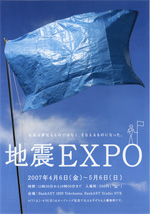 |
 |
| Jishin (Earthquake) EXPO |
| 6 April - 6 May 2007 |
BankART 1929 Yokohama / Studio NYK
(Kanagawa) |
 |
| With the theme of "disaster prevention and creativity," this Expo features documentation (photos, videos, picture books) of the destructive Kobe and Niigata earthquakes, "disaster prevention goods" (some on sale) devised by artists, and evacuation shelters designed by architects, as well as a shelter-building workshop. |
|
 |
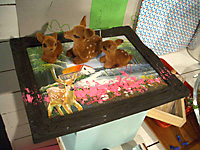 |
 |
| Namaiki: Kinky Muff Land |
| 7 April - 13 May 2007 |
graf media gm
(Osaka)) |
 |
| Namaiki (lit. "naughty") is a Tokyo-based creative unit consisting of New Zealand-born David Duval-Smith and U.K.-born Michael Frank. This show features installations, collaborations with other artists, and live performances centered around the theme of "farming in the city." |
|
 |
 |
 |
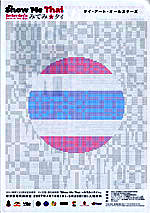 |
 |
| Show Me Thai |
| 18 April - 20 May 2007 |
Museum of Contemporary Art, Tokyo
(Tokyo) |
 |
| Commemorating the 120th anniversary of Thai-Japan amity, this retrospective of cultural exchanges between the two nations includes paintings, sculptures, videos, installations, films, animations and music. Featured are contemporary Thai artists like Navin Rawanchaikul and Rirkrit Tiravanija as well as Japanese artists connected to Thailand. |
|
 |
 |
 |
| Ai-Mitsu |
| 30 March - 27 May 2007 |
National Museum of Modern Art, Tokyo
(Tokyo) |
 |
The uniquely fantastic and surreal paintings of Ai-Mitsu (born Nichiro Ishimura, 1907-46), produced before and during World War II, had a profound influence on modern Japanese art. Commemorating his birth centennial, this retrospective brings together some 130 of Ai-Mitsu's works.
|
|
 |
 |
 |
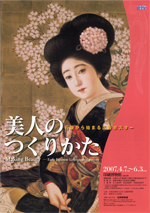 |
 |
| Making Beauty: Early Japanese Lithographic Posters |
| 7 April - 3 June 2007 |
Printing Museum, Tokyo
(Tokyo) |
 |
| Poster advertising and planographic printmaking both arrived in Japan during the Meiji era, and lithographic poster art has flourished here ever since. This show focuses on the "bijinga" (pictures of beautiful women) genre of advertising, featuring some 160 posters and original drawings from the late Meiji and prewar Showa periods. |
|
 |
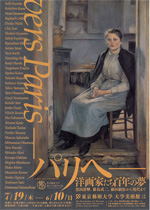 |
 |
| Les peintres japonais occidentalisants et Paris: un rêve séculaire |
| 19 April - 10 June 2007 |
University Art Museum, Tokyo National University of Fine Arts
(Tokyo) |
 |
| In the early 1900s Japanese painters began looking to Paris for new modes of thinking and expression; their efforts had a powerful impact on Western-style art in Japan. This show traces the footsteps of artists who migrated to Paris, including Seiki Kuroda, Takaji Fujishima, Ryuzaburo Umehara, Sotaro Yasui, and Leonard Foujita. |
|
 |
 |
 |
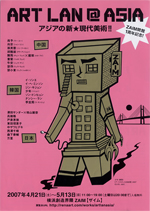 |
 |
| ART LAN @ASIA |
| 21 April - 13 May 2007 |
ZAIM
(Kanagawa) |
 |
| This is an exhibition of contemporary East Asian art by the ZAIM project, known for holding art events in historical buildings in the harbor district of Yokohama. Exhibits showcasing artists and art groups from Japan, Korea and China are accompanied by musical events, films and symposiums. |
|
 |
 |
 |
| Masumi Hara: Complete Works! |
| 21 April - 24 June 2007 |
Meguro Museum of Art, Tokyo
(Tokyo) |
 |
| Musician Masumi Hara is also an illustrator of books, magazines and record jackets. He is particularly known for his illustrations of the best-selling novels of Banana Yoshimoto. This show offers a full retrospective of Hara's graphic work to date. |
|
 |
 |
 |
 |
 |
| Marlene Dumas: Broken White |
| 14 April - 1 July 2007 |
Museum of Contemporary Art, Tokyo
(Tokyo) |
 |
The South African-born artist paints vivid portraits based on images from the mass media and draws on her own experience with apartheid to address issues confronting contemporary society: prejudice, discrimination, ethnicity, sexuality, gender.
|
|
 |
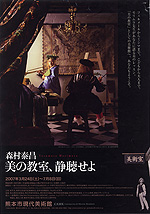 |
 |
| Yasumasa Morimura: "Bi[bi:]-Class, Be Quiet" |
| 24 March - 8 July 2007 |
Contemporary Art Museum Kumamoto
(Kumamoto) |
 |
| Known for photographic self-portraits in which he inserts himself into reproductions of world-famous artworks, Morimura has fashioned this retrospective as an "art history tour," dividing the exhibit space into six classrooms respectively devoted to his versions of Vermeer, Van Gogh, Rembrandt, La Gioconda, Frida Kahlo, and Goya. |
|
 |
 |
|